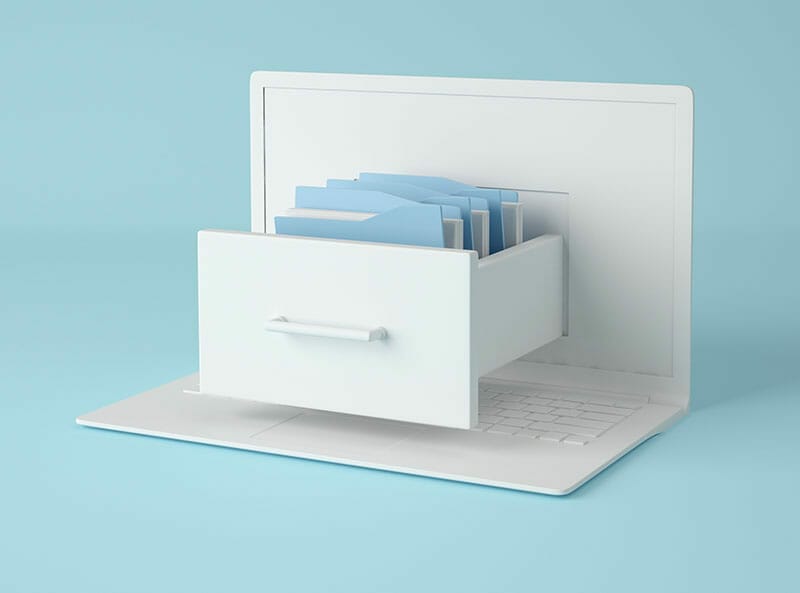
Going paperless is becoming standard in the business world. If your company has not converted to electronic filing, now is a great time to understand the benefits of digital documents and what steps you can take to implement an electronic filing system.
What Are the Benefits of Using an Electronic System?
Digital copies won’t deteriorate. Over time, paper documents can fade, fall apart, incur water damage, or disappear altogether. On the other hand, electronic documents that are added to a filing system will stay in the same condition forever.
It’s more secure. Anyone can access a paper document if they are in the same room. Electronic documents are harder to view, particularly when password protected.
You will have a paperless backup. If you love using a physical filing system or need to keep original copies of paper documents, making a digital backup of all files ensures that you don’t lose those documents. As mentioned above, paper can easily get lost or damaged but digital files will stay intact — especially if you store them in the cloud.
Electronic systems are easily searchable. Finding a misplaced paper document can take a lot of time out of your day. With an electronic system, a quick search will help you find it even if it is filed incorrectly.
Step One: Create a Plan
Set Rules
Begin by creating standard rules for adding and sharing documents. This ensures that the documents are consistent across the entire system, labeling: folders, documents, section off by years, etc. If you have an existing framework that works for you, implement it in the new digital filing system. Create any templates or guidelines that will keep the process consistent.
Plan Digital Conversion
How are documents going to be converted from paper copies to digital? The files will need to be scanned in order to set up an electronic filing system. There are a few options for this:
- Purchase a document scanner or use the scanner on your printer. Many printers already have a scanner built into the device and are perfect for scanning important documents. If you don’t have a scanner attached to your printer, compact scanners are available specifically to use in document digitization.
- Use a mobile app. Apps like Adobe’s Scan to PDF and the Dropbox Scan App allow users to capture PDFs with their camera. Both of these options are free but require a phone or tablet to use.
- Take a picture. In some cases, simply taking pictures of your documents is the right option. It’s best to convert the pictures to PDFs, but it isn’t a necessity. Naming and filing them correctly is probably more important.
Choose Security Protocol
Most businesses have sensitive documents in their filing system. Luckily, security protection is offered in most business file management services. If using your computer’s File Manager, secure files by password protecting them. Adobe Acrobat offers a way to secure PDFs with passwords and restrict editing so that they can’t be accessed by anyone without permission.
Communicate to Stakeholders
Once you decide on a plan, it is important to let anyone that will be using the system understand how it is structured. Make sure everyone is aware of any rules, guidelines, and methods of accessing files in the new system.
Step Two: Choose the Right Software
Business Document Management Systems
Document management systems like Microsoft Box or Revver Docs are cloud-based software designed specifically with SMBs in mind. These streamlined tools provide APIs that allow for integration with other business tools and help with tracking documents through the workflow. They also work well for basics like creating, sharing, and editing documents.
Cloud File Management
Cloud document storage like Dropbox or Google Drive can also be used for storing documents but doesn’t offer the same business-friendly features. It works like a literal filing cabinet where documents can be stored and secured, but not tracked, and has limited integration capabilities.
File Manager
All computer operating systems come with a version of File Manager. On Windows, this is called File Explorer and on Mac OS, it is called Finder. This is the tool that allows you to organize files into folders. Since filing systems follow the same set of rules, it’s easy to implement a filing system that mirrors a physical filing cabinet. While this is the most secure filling setup, as it allows for password protection and local storage, it is also the riskiest in terms of losing data. Always make an external backup of files if you are storing them on your computer.
Step Three: Set Up the System
Create a Filing Structure
There is no right way to set up a filing structure. Use a structure that works for your specific business, whether that be sorted alphabetically, chronologically, by category, or using another method. Then ensure everyone using the system understands how to navigate the new filing structure.
Use Consistent Naming
Consistently naming files makes searching for documents easy. With standard naming rules, users are able to quickly understand what information is in a document. Use the filing structure to your advantage by including any important details in the name, like date or version number.
Download Files that are Already Electronic
Many files are already in electronic form. These include credit card statements, bank statements, utility bills, and many receipts. It is not wise to assume those electronic copies will stay on the vendor’s site for as long as you may need access to them. Often they are deleted within 2 years and sometimes sooner. Make sure one of your processes includes downloading all of the electronic files from your vendor sites on a consistent basis, but at minimum once a year.
Step Four: Perform Maintenance
Declutter Checks
Like buildings, filing systems cannot be built and then ignored. Schedule decluttering checks every 6-12 months to get rid of any files that do not need to be in the system. This may include duplicates, abandoned files, or any other useless data.
Periodically Archive Files
While decluttering checks, archive any files that should not be deleted but that are no longer in use. Things like tax documents from previous years or clients that you no longer work with can be archived. Archiving files is as easy as adding them to an archive folder where they are still accessible but don’t interfere with daily operations.
Understand What Documents to Keep
It is tricky to know how long to keep different financial records. As a rule of thumb, always keep documents if you’re unsure of how long to keep them. With an electronic filing system, those documents won’t take up that much extra room and can be kept until you are sure you no longer need them.
When in doubt, keep these documents:
- Business tax returns
- Financial statements
- General ledger
- Bank statements
- Credit card statements
- Check registers
- New hire forms
- Receipts
- Contracts
- Business agreements
- Permits and licenses
- Insurance documentation
- Payroll records
| Document | How long to keep |
|---|---|
| Records on which wage calculations are based | 2 years |
| Income tax return records | 3 years |
| Payroll records | 3 years |
| Sales and purchase records | 3 years |
| Bad debt reduction claim | 7 years |
| Income tax return records if you do not file a return | Indefinitely |
Moving your filing system from paper to electronic seems like a big undertaking but will save time and money in the long run. Besides not having to worry about losing documents, an electronic filing system is easier to manage and find information. If you need help setting up your financial filing system, contact Simply Counted and Tax for assistance.
About The Author

Diana Kasza
Former President of Simply Counted Business Services, Inc.Diana is an Accredited Business Accountant/Consultant with more than 25 years of experience. She is a graduate of Ferris State University and an active member of Toastmasters International.